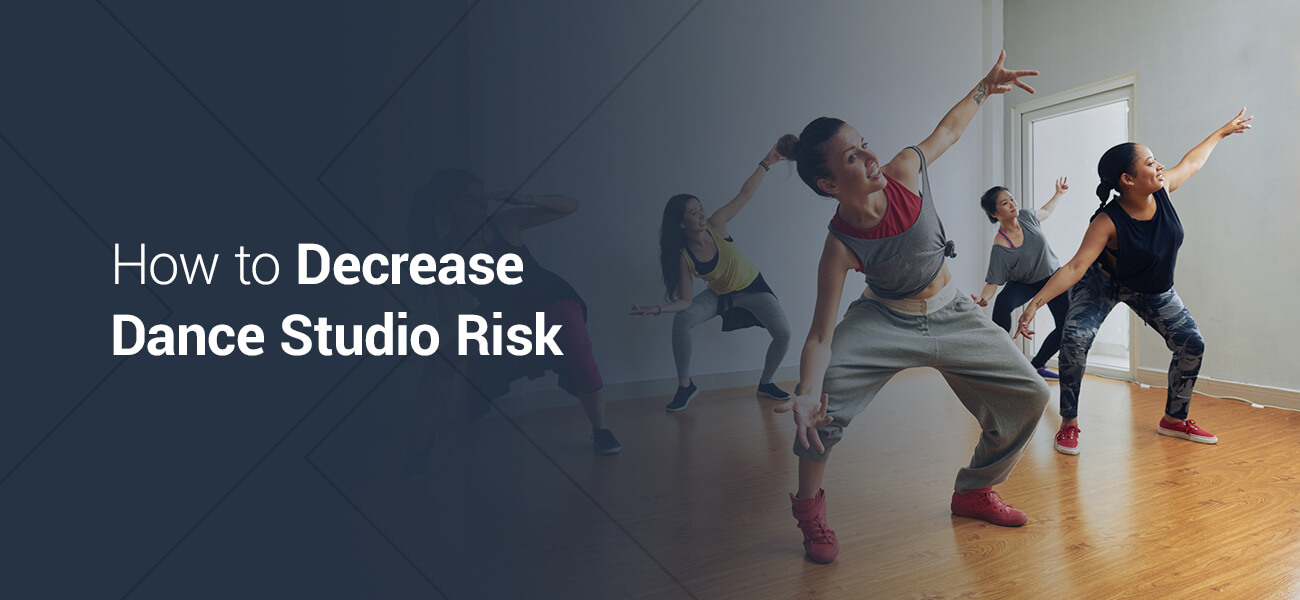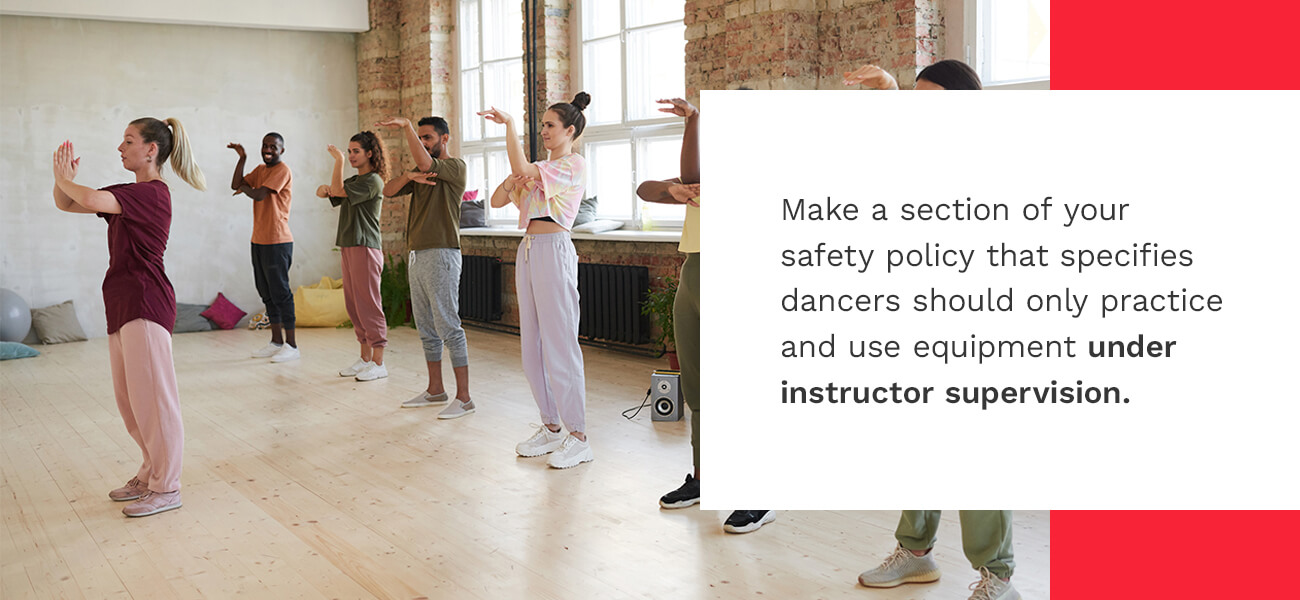
How to Decrease Dance Studio Risk
As a dance studio owner, you help people of all ages develop dancing skills and become accomplished dancers. Despite helping dance students chase their dreams, your role includes liability risks, which puts your finances at stake. Whether it be an accidental injury or damage to your studio, the costs could be coming out of your pocket.
To protect your finances and the business you’ve built, you need to take action to decrease the risk present in your dance studio. Learn several ways you can help decrease your dance studio’s liability risk below.
Tips for Decreasing Dance Studio Liability Risk
To create a safe environment for professional dancers to learn and practice, you need to understand the potential risks you could be facing. Consider the following tips to help reduce your studio’s liability risk:
1. Preventative Measures
Dance studios should take preventative measures to help protect themselves against liability risks. Two important documents to create include a safety policy and a customer waiver.
Your safety policy should be a straightforward outline of all the rules you’ve established for your customers’ safety. It may include numerous items, like a policy specifying proper footwear. For example, you may indicate that dancing barefoot or with footwear that has too much cushion creates a risk of injury. Your safety policies should be displayed and regularly reviewed.
Waivers are crucial for helping dancers and their families understand dance studio safety. Make your participants aware of the importance of safety during dance classes and what they can do on their end to reduce any risk of injury. Asking dance class participants to sign a waiver helps mitigate liability risks because it proves your members were aware of your safety policies.
Waivers of this nature are considered legal documents. To ensure you’re creating a proper, simple waiver, consider consulting with an attorney. While there’s a cost for their expertise and service, paying for the help ahead of time can save you significant amounts of money in the long run. If you prepare an effective waiver now, it could help protect you from costly liability claims in the future.
2. Maintain Distance Between Dancers
To avoid spreading germs between dancers, ask your customers to maintain distance between each other when in classes or rehearsing. Distancing can help prevent the spread of COVID-19 and other illnesses. While there are many factors at play here, ensuring social distancing during class times helps ensure you did your part to keep your customers safe.
3. Limit Class Sizes
Depending on the size of your rehearsal area, you may want to limit your class sizes. Overcrowding a room increases the likeliness of germs being spread because people have to stand closer to each other so everyone fits in the room. Additionally, putting space between dancers ensures they have enough room to safely perform routines.
Limiting the number of people per class or rehearsal helps ensure there’s adequate and safe space between each customer. You may even offer individual lessons or rehearsal times to provide safer options for customers.
4. Limit Socializing Indoors
Similarly to maintaining distance during classes, be sure to encourage dancers to limit socialization with each other indoors before and after classes. Socializing in close spaces like hallways or dressing rooms can increase the chances of customers spreading illnesses like COVID-19. Let your customers know they should wait in their cars or outside the building before classes and head outside promptly after classes end to limit the spread of germs.
5. Remove Trip or Slip Hazards
Trip and slip hazards offer some of the highest injury prevalence in dance studios. Dance studio floors are intended for specific use with specific footwear. Any object or substance on the floor could cause staff or customers to fall and sustain injuries.
General housekeeping typically helps eliminate trip and slip hazards. Be sure to maintain timely cleanup regimens and use “wet floor” signs when a spill can’t be immediately addressed. Ensure objects are put away or kept off the floor to ensure no tripping hazards on the studio floor.
Another aspect of slip hazards you should consider is the cleaning agents and waxes used on your dance floors. Whether you handle the cleaning and waxing or have a cleaning company come in, be sure the substances being used won’t make the floor too slippery. Avoid using excessive amounts of wax to prevent creating slippery situations. Look for products that will allow your dancers to safely use the studio floor after you’ve cleaned it.
Staff, customers, and dancers can help remove trip and slip hazards to keep the studio as safe as possible. Ask all parties to keep their belongings in designated areas, clean up after themselves, and report hazards to the staff to limit hazardous risks.
6. Provide Adequate Lighting
It may go without saying that dark spaces are more difficult to see in, creating a recipe for hazards and incidents. If there’s a spill in a poorly lit area, participants may not see the spill to avoid it or report it. This could result in dancers and staff injuring themselves.
Providing adequate lighting in hallways, staircases, locker rooms, and other spaces around your dance studio can help decrease your liability risk and help ensure everyone stays safe. Staff members and customers will be more likely to see slip or trip hazards and the general safety of your dancers and employees will increase.
7. Ensure Classes Are Supervised
Some dance moves can be dangerous and lead to injury if performed incorrectly or without supervision. Any activity in your dance studio should be supervised. Make a section of your safety policy that specifies dancers should only practice and use equipment under instructor supervision.
Also, keep instructor-to-student ratios in mind. While the numbers may vary depending on skill levels and age groups, all classes and rehearsals should have an appropriate teacher to dancer ratio to ensure dancer safety. When an instructor is left to supervise too many individuals, the instructor can’t supervise everyone properly to ensure total safety.
If dancers use special equipment or perform risky moves and sequences, provide the necessary supervision. Your dance studio could be liable for any injuries sustained as a result of a lack of supervision. Providing appropriate supervision will help decrease the risk of liability in these situations.
8. Hire Educated and Certified Instructors
The dance instructors you hire can make a difference in the credibility of your studio and affect your liability risk. Any employees in your studio should undergo background checks to ensure they’re cleared to work with and around kids. Additionally, any instructors you hire should have proper certifications to teach dance.
Without certification, it’s difficult to ensure your instructors can teach proper techniques. Hiring educated, certified dance teachers helps ensure you’re encouraging a safe learning environment. Plus, you can be confident your customers will learn the correct techniques, decreasing the risk of injury.
9. Take Care of Your Facility and Equipment
If there are faults or issues with your facility or equipment, you’re likely to be considered the liable party for any accidents or injuries. Take measures to ensure your facility and equipment is in good condition. Regularly inspect your studios for signs of leaks and other damage. All equipment should also be regularly inspected and replaced if necessary to prevent injuries.
10. Develop an Emergency Response Plan
An emergency response plan helps ensure your employees are prepared in crisis situations. Whether it be a medical emergency or a natural disaster, your employees and dance instructors need to know what to do.
Create a document specifying what tasks need to be done in specific situations and who needs to do those tasks. The important thing to keep in mind here is that your emergency response plan should be specific to your studio to ensure the safety of your staff and students.
You may also have your local emergency personnel review your emergency response plan to ensure it’s efficient and effective. They can offer guidance and advice to improve your plan. Once the plan is complete, practice it occasionally with your staff and students so everyone knows what to expect.
11. Purchase Dance Studio Insurance Coverage
Life is unpredictable and accidents happen. To best protect yourself and your studio from situations out of your control, purchase dance studio liability insurance. When looking for liability insurance, it’s important to not choose just any policy. Dance studios have their own set of risks and needs, which means you need an insurance policy tailored to your business.
There are various “what if” situations that could result in lawsuits, so it’s best to have as much coverage as possible. On top of your general accident and liability coverage, consider adding insurance for property damage, alleged sexual assault, special events, communicable disease, errors and omissions, and other coverages you feel may be necessary for your studio.
Contact Us to Learn More About Managing Dance Studio Risk
Unfortunately, many insurance providers won’t offer dance studio liability coverage because of the risks and potential for high payouts. Luckily, XINSURANCE specializes in offering liability insurance solutions that are difficult to find elsewhere.
We help businesses like yours with special liability risks find the necessary coverage. At XINSURANCE, we’ll help you write a custom plan to help reduce your exposure to risks associated with your business.
To get your free dance studio insurance quote, contact us today and an experienced member of our team will get in touch with you.

Rick J. Lindsey hails from Salt Lake City, Utah. He began working in the mailroom of his father’s Salt Lake City insurance firm, getting his introduction to the business that became his lifelong career. Rick J. Lindsey quickly rose through the ranks while working in nearly every imaginable insurance industry job. As an entrepreneur, specialty lines underwriter, claims specialist, risk manager, and a licensed surplus lines broker, Rick J. Lindsey is highly skilled in all levels of leadership and execution. As he progressed on his career path, Rick J. Lindsey discovered an urgent need for insurers willing to write policies for high-risk individuals and businesses. He was frequently frustrated that he could not provide the liability protection these entities desperately needed to safeguard their assets. He also formed the belief that insurance companies acted too quickly to settle frivolous claims. Rick J. Lindsey decided to try a different approach. He started an insurance company and became the newly formed entity’s CEO. This opportunity has enabled Rick J. Lindsey to fill a void in the market and provide a valuable service to businesses, individuals, and insurance agents who write high-risk business. XINSURANCE also specializes in helping individuals and businesses who live a lifestyle or participate in activities that make them difficult for traditional carriers to insure. If you’ve been denied, non-renewed, or canceled coverage, don’t give up quite yet. Chances are XINSURANCE can help.



